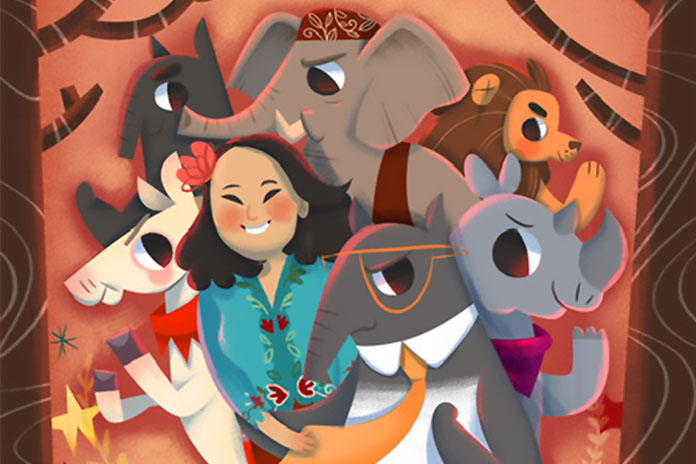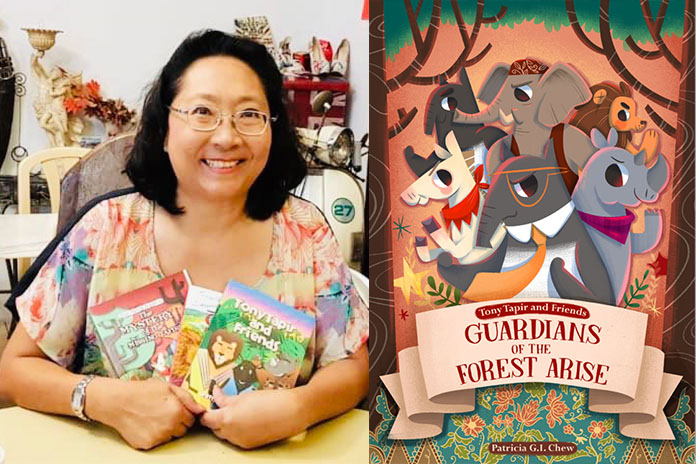
EVERYONE has a story or few forming in their heads. For most, they will never get past the formative stages, eventually being locked away, fading even from recall.
Patricia Chew acts on her ideas. The author of three books of action adventure around anthromorphised characters that bring the issues of sustainability, conservation and leadership to life, has penned a fourth in the Tony Tapir and Friends series. What was originally meant as a trilogy, ended with a cliffhanger, so there was clamour for a fourth book, and Patricia obliged.
Guardians Of The Forest Arise, will be released in Malaysia and Singapore this month, and continue the adventures of these intrepid denizens of the regional jungles.
Patricia, a lawyer by profession, talks about some of the issues and inspirations behind her series.

STORM-ASIA: How do you write books for children who are growing up in a digital environment?
PATRICIA CHEW: Being aware of the use of new technology and animation, I have asked both children and adults to read my scripts or drafts in their initial stages and asked for their feedback.
As a result of this exercise, sometimes I have had to change the way I would normally present things. For instance, having been trained in a legal environment, I had to “childrenise” the way I write things. I have also had to be less “preachy” and resist the temptation of always spelling things out because it can sometimes take the fun out of the children having to work things out themselves.
The style which I have adopted in writing all my books are different because I want my target audience — children aged 9 to 12 — to grow with the series. For this reason my latest book has become pacier and is more action packed. Certainly it is not intended to be a walk in the park.
More After This…
STORM-ASIA: What are some of the pressing issues you feel your stories have addressed?
PATRICIA: The young readers would understand about some of the habits of the animals. For instance tapirs like eating berries. However I have humanised this slightly by spinning the story about Tony Tapir’s wife and Muna Monkey having a berry bun business in the third book The Mystery Of The Missing Tapirs and in my upcoming book.

They would also understand the importance of certain values in leadership. For instance, in my first book, Tony Tapir and Friends, the children are taught about the importance of having vision in leadership and the passion to run with the vision. The protagonist in this part of the story is Rex the Lion who has a vision for rebuilding the broken down walls and fortresses in Spice Garden, which is where the lions live in Evergreen Forest.
The importance of keeping pacts or your end of the bargain in relationships. For instance, Muna Monkey who distrusts Rex the Lion tries to hinder his vision by throwing coconuts at Rex and his pride of lions. Enter Rajah the Elephant, Rex the Lion’s trusty sidekick, who keeps a pact which he made with Rex the Lion. The pachyderm warns the lions by making trumpeting noises whenever he spots some Monkey business.
The importance of integrity in leadership is highlighted in all four books, in particular my upcoming book which tells the young reader why a good leader like Tony Tapir should be followed and who should not be emulated, in this instance, his predecessor.
The importance of bereavement counselling for the young when someone has lost a loved one. In my first book, I share with young readers how the tapirs and horses visit Oona Orangutan when she loses her daughter.
STORM-ASIA: What has been the response to your books?
PATRICIA: When it comes to the habits of tapirs and the negative aspects of slash-and-burn deforestation techniques, the response has been positive. When I wrote my second book, The Quest for the Great Pearl, I had the unswerving support of Kanda Kumar, the ex-Chairman of the Malaysian Nature Society, who understood my concern for endangered or vulnerable creatures such as the tapirs, Javan and Sumatran Rhinoceroses and other creatures. He obliged me by writing a foreword to that book. Interesting aside, the logo for the Malaysian Nature Society is a tapir.
The then Chief Minister of Penang and now Finance Minister, Lim Guan Eng, very kindly obliged me by agreeing to launch the same book.

A savant, Delwin Cheah, who attended the book launch, drew huge posters of the vulnerable tapir together with the caption, “Save the Tapir!” Many children signed their names as a form of solidarity with us who wanted to campaign for the tapir’s precarious survival.

Readers have responded positively to the importance of having a vision and passion with respect to leadership. During the launch of the second book, Minister Lim Guan Eng narrated the story about a man whose friend wanted him to enter into a dodgy business transaction. The man refused his friend and was persuaded a second time by his friend. This time his friend said: ”Don’t worry, only you know and I know.”
However to his friend’s chagrin he rejected his friend by saying,” You are wrong. You know, I know and God knows”. Surely, if we have a conscience we should maintain our integrity.
STORM-ASIA: Do you think in this era of short attention span, readers are able to follow multiple threads in a story that weave into a tapestry?
PATRICIA: My humble opinion is that if the plot is interesting enough and if the reader has a connection with the different protagonists, by identifying with their feelings and thoughts, then they will be able to follow the multiple threads of a story . However if there is a lack of connectivity, then the attention span will easily be lost.
STORM-ASIA: How do foreign audiences relate to the tapir, and has his standing risen as a result of your books?
PATRICIA: Foreign audiences have been quite receptive to the stories of Tony Tapir and his friends. My books are available in Singapore, Malaysia and Myanmar. Hopefully, the stories will spread throughout ASEAN.
In Singapore, my books have been picked up by Chinese and Japanese readers who believe the myth that the tapirs eat or devour bad dreams.
STORM-ASIA: What does writing these books do for you?
PATRICIA: Firstly, I feel that I have stories to share with the children and perhaps a few adults who read my books. Some of these stories were inspired by newspaper reports, e.g. in my first book, Tony Tapir And Friends, the orangutans and other animals are murdered mysteriously and they have to go deeper into the forests. This story appeared in a Malaysian newspaper which I had read when I was on holiday in Kuala Lumpur. The orangutans died because man had destroyed their natural habitat to grow lucrative oil palm.
Secondly, I can exercise my scant creative juices although I never majored in literature in university, and I find satisfaction in this…whether or not people like what I write. Writing is a cathartic exercise that enables me to ameliorate the troubles in the world, but only partially, in my limited sphere. Of course , one wishes one could do more.




















